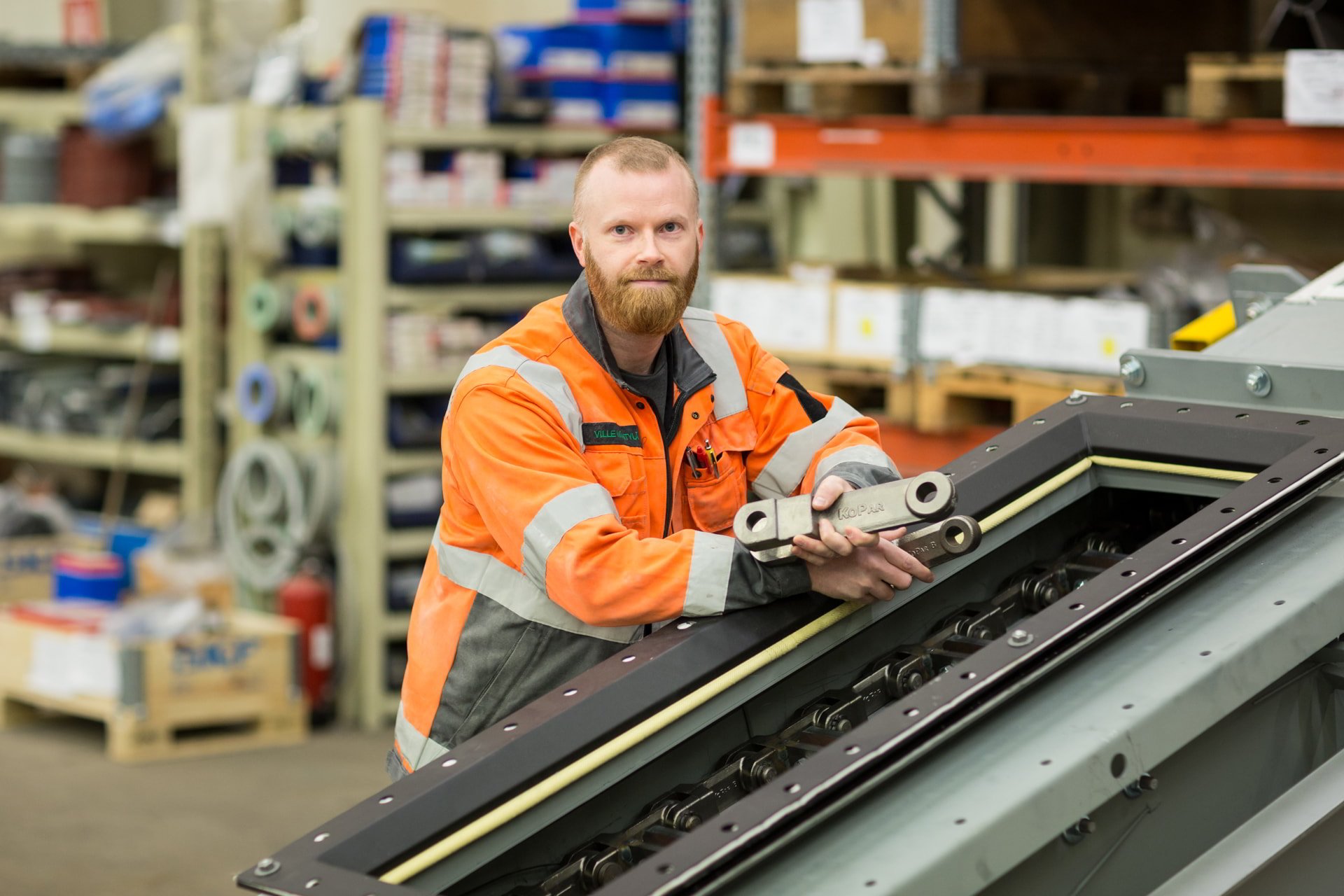What is a chain conveyor?
A chain conveyor is a material handling device designed to efficiently and continuously move bulk materials. Its basic components include a conveyor chain, drive sprocket, rails, and control system. Chain conveyors are primarily used in industrial logistics and production lines where the management of material flows is critical.
A chain conveyor differs from other transport systems, such as conveyor belts, as it can handle heavier and coarser materials and is well-suited for demanding conditions. Its enclosed structure allows for the control of dust and spills, making it an ideal choice in environments where cleanliness and safety are paramount.
The conveyor chain is a central part of the chain conveyor and is typically made from durable steel. This construction ensures that the chain conveyor can handle large volumes of material efficiently, making it a reliable solution for a variety of industrial needs.
How does a chain conveyor work?
The operation principle of a chain conveyor is based on the movement of the conveyor chain by drive sprockets. The drive sprockets rotate the chain, which moves the material along the rails. This movement is precisely controlled to ensure smooth and efficient transportation.
The collaboration between the conveyor chain and drive sprockets is key to efficiency. The chain must be durable and flexible enough to transport materials of various sizes and weights. Additionally, the drive sprockets must be precisely designed to manage the movement of the chain without unnecessary friction or wear.
Overall, the chain conveyor operates seamlessly with various components, ensuring reliable and efficient material handling. This makes it an excellent choice for many industries that require high performance and low maintenance needs.
What are chain conveyors used for?
Chain conveyors are widely used in various industrial applications where effective material handling is required. They are common on production lines, where they move raw materials and finished products from one part of the process chain to another. This makes production processes smoother and reduces the need for manual labour.
In warehouse logistics, chain conveyors are indispensable as they enable rapid and systematic movement of materials. They can handle large volumes of materials, such as sand, stones, and chemicals, making them ideal for warehouses where space utilization and efficiency are important.
Chain conveyors are also useful in industries such as metallurgy and power plants, where they can transport hot and abrasive materials safely. This wide range of applications makes them an important part of the logistics systems of various industries.
What advantages do chain conveyors offer?
Chain conveyors offer many advantages that make them a popular choice in industrial logistics. Firstly, their efficiency is unmatched, as they can move large amounts of material continuously and evenly. This improves the smoothness and efficiency of production processes.
Reliability is another significant advantage. Chain conveyors are simple yet durable in construction, reducing maintenance needs and extending their service life. This makes them cost-effective in the long term, even though the initial investment may be large.
Chain conveyors are also flexible and versatile. They can be used in various applications and environments and can handle a wide range of materials. This versatility makes them valuable tools for industrial material handling.
How are chain conveyors installed and maintained?
The installation process of chain conveyors must be carefully planned for optimal operation. The first step is selecting the right type of chain conveyor that precisely meets the requirements of the material being handled. The choice of installation site and arrangements are also critical for the conveyor to operate efficiently and safely.
After installation, regular maintenance is important to keep the chain conveyor's performance high. This includes checking parts for wear, tightening the chain, and replacing parts if necessary. Regular maintenance can prevent unexpected downtime and extend the device's lifespan.
Designing and implementing a maintenance program is crucial to maximizing the availability of the chain conveyor and minimizing its lifecycle costs.
What are the challenges of chain conveyors?
There can be several challenges in using chain conveyors that need to be considered. One of the most common issues is wear, which can result from continuous use or the characteristics of the material being transported. This can lead to maintenance needs and potential downtime.
Another challenge relates to installation and space requirements. Installing a chain conveyor requires careful planning to fit into the available space and operate efficiently. This can be particularly challenging in spaces with limited free space.
However, with the right measures, such as regular maintenance and precise planning, these challenges can be effectively addressed. This way, chain conveyors can continue to operate reliably and efficiently in various industrial applications.

You have a challenge that needs solving?
Let us help! Contact us for more information about our products and services.
